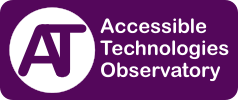Education on Design for All in Road, Channel and Port Engineering Curriculum
After publishing the “White Book of Design for All in Universities” in 2006, as a result of the cooperation between the Coordinadora del Diseño para Todas las Personas en España, the Instituto de Mayores y Servicios Sociales (IMSERSO), the Fundación ONCE para la Cooperación e Inclusión Social de Personas con Discapacidad and different bodies at Spanish universities, and in accordance with the very positive acceptance of both the concept of Design for All and the various contributions made throughout the first project, the
